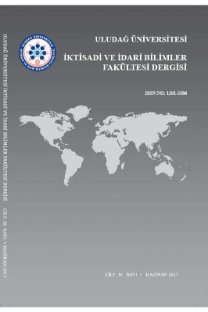Sistematik Risk Tahmininde Getiri Aralığının Etkisi: İMKB'de Bir Uygulama
Sistematik riskin veya betanın tahmini finans alanında bir çok uygulama için önem taşır. Getirilerin hesaplanma şekli, tahmin süresi, kullanılan piyasa endeksi gibi faktörlerin bir hissenin beta tahmininin değişik değerler almasına neden olduğu bilinmektedir. Bu çalışmanın konusu beta katsayısı hesaplanırken kullanılan getiri değerlerinin hangi aralıklarla ölçüldüğünün beta tahminlerini üzerindeki etkisidir. Getiri aralığı etkisi yabancı piyasalarda incelenmiştir. Bu çalışmada getiri aralığı faktörü Türkiye menkul kıymetler piyasası için 1992-1999 periyodunda, 100 hisseden oluşan bir örneklemle incelenmiştir. Elde edilen bulgulara göre getiri aralığı uzadıkca beta katsayılarının arttığı yönündedir. Yabancı piyasalarda yapılmış çalışmalarda ortaya çıkan “getiri aralığı uzadıkça küçük (büyük) şirketlerin beta değerleri artar (azalır)” şeklindeki sonuç, diğer bir deyimle beta tahminleri üzerindeki “piyasa değeri” etkisi Türkiye piyasasında net olarak görülmemektedir.
Anahtar Kelimeler:
risk
The estimation of systematic risk, or beta, is critical to many applications in finance. It is known that a variety of beta estimates can result for the one stock depending on various factors such as the calculation of returns, length of the estimation period and the choice of market index. In this paper, we are concerned with one such factor being the interval over which returns are measured. The impact of the return interval on the beta estimate has been investigated in foreign markets.This paper investigates the same issue for the Turkish equity market over the 1992- 1999 period with a sample of 100 equities. The initial results indicate that the beta estimate rises as the return interval is lengthened. The finding in previous research conducted in foreign markets is that “the beta estimates of high (low) capitalised firms fall (rise) as the return interval is lengthened.” According to our findings, this size effect is not apparent in Turkish equity market.
Keywords:
risk,
___
Blume, M. (1971), On the Assessment of Risk, Journal of Finance, 26, 1-10.Blume, M. (1975), Betas and Their Regression Tendencies, Journal of Finance, 30, 785-95.
Bos T., Newbold, P. 1984. An emprical investigation of the possibility of stochastic systematic risk in the market model. Journal of Business 57, 35-41.
Brailsford, T.J., Josev, T. 1997. The impact of the return interval on the estimation of systematic risk. Pacific-Basin Finance Journal 5, 357-376.
Brooks, R.D., Faff, R.W., ve Lee, J.H.H. 1992. The form of time variation of systematic risk: Some Australian evidence. Applied Financial Economics 2, 191-198.
Chan, L., ve Lakonishok, J. 1992. Robust measurement of beta risk. Journal of Financial and Quantitative Analysis 27, 265-82.
Cohen, K., Hawawini, G., Mayer, S., Schwartz, R., ve Whitcomb, D. 1983.
Estimating and adjusting for the undervaluing effect bias in beta. Management Science 29, 135-148.
Collins, D.W., Ledolter, J., ve Rayburn, J. 1987. Some further evidence on the stochastic properties of systematic risk. Journal of Business 60, 425-448.
Dimson, E. 1979. Risk management when shares are subject to infrequent trading. Journal of Financial Economics 7, 197-226.
Fama, E., ve French, K. 1992. The cross-section of expected returns. Journal of Finance 47, 427-465.
Frankfurter, G. L., ve Brockman, P. 1994. Compounding period length and the market model. Journal of Economics and Business 46, 179-93.
Handa, P., Kothari, S.P., ve Wasley, C. 1989. The relation between the return interval and betas: Implications for the size effect. Journal of Financial Economics 23, 79-100.
Handa, P., Kothari, S.P., ve Wasley, C. 1993. Sensitivity of multivariate tests of the capital asset pricing model to the return interval measurement. Journal of Finance 48, 1543-1551.
Kim, D. 1993. The extent of non-stationarity of beta. Review of Quantitative Finance and Accounting 3, 241-54.
Lewis, K. 1991. Should the holding period matter for the intertemporal consumption-based CAPM? Journal of Monetary Economics 28, 365-389.
Roll, R. 1981. A possible explanation of the small firm effect. Journal of Finance 36, 879-888.
Scholes, M., ve Williams, J. 1977. Estimating betas from non-synchronous data. Journal of Financial Economics 5, 309-327.
Shalit, H., ve Yitzaki, S. 2001. Estimating Beta. Working Paper, Department of Economics and Finance, Ben Gurion University.
Turtle, H.J. 1994. Temporal dependence in asset pricing models. Economics Letters 45, 361-366.
Vasicek, O. 1973. A note on using cross-sectional information in Bayesian estimation of security betas. Journal of Finance 28, 1233-1239.
- ISSN: 1301-3386
- Yayın Aralığı: Yılda 2 Sayı
- Başlangıç: 2018
Sayıdaki Diğer Makaleler
Bootsrap Yönetiminin Ridge Regrasyonda Uygulanması
Zaman Serilerinde Değer Tarama Süreçlerini Modelleme ve Performans Analizi
Artık Getirilerde Haftanın Günü Firma Büyüklüğü ve Takas Süresi Etkisi
RAHMİ YÜCEL, MURAT ÖZCAN, Ayşe T. ÇETİN
Hüdaverdi BİRCAN, ZAFER KARTAL
Öngörü Tekniklerinin Doğruluk Kıyaslaması: Basit Ekonometrik, ARMA ve ARMAX Teknikleri
Kriz Yönetimi: Teori, Tartışma ve Türkiye Örneği
Büyük Bir İktisatçının Metafizik Değer Yargılarına Bakışı: Joseph A. Schumpeter'in Vizyon Kavramı
